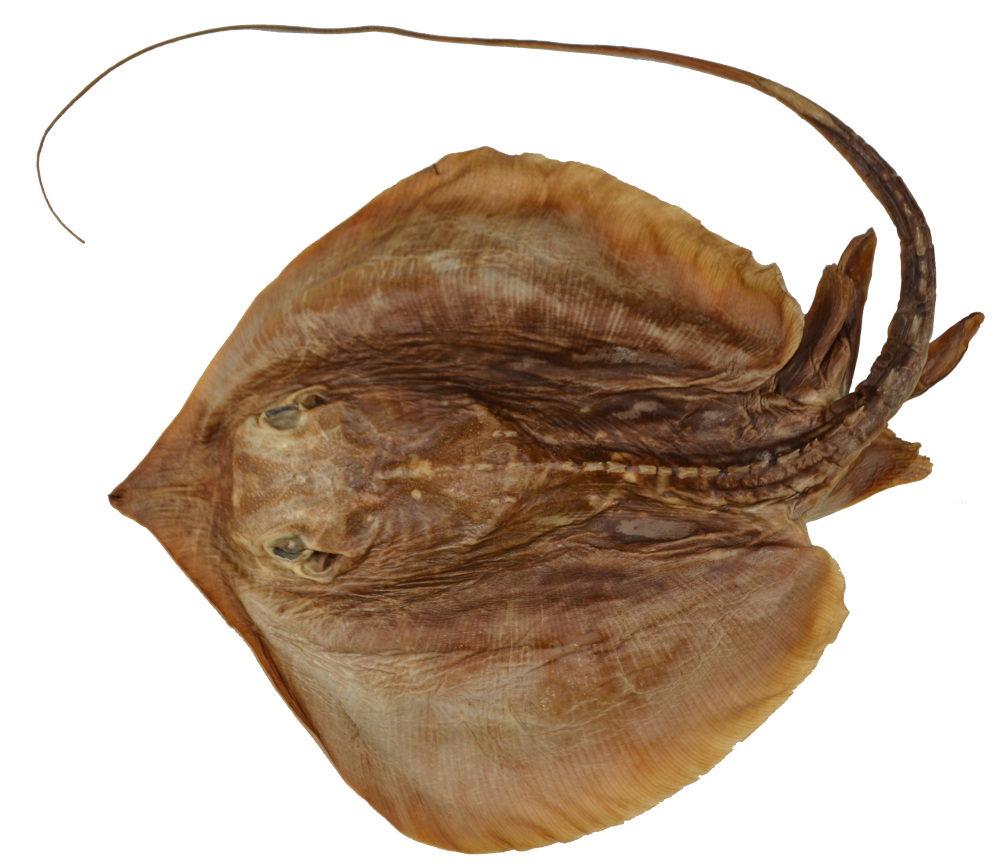Hemitrygon yemenensis
Moore & Last & Naylor, 2020
Classification: Elasmobranchii Myliobatiformes Dasyatidae
Reference of the original description
Hemitrygon yemenensis sp. nov., a new species of stingray (Myliobatoidea: Dasyatidae) from the northwestern Indian Ocean. Zootaxa, 4819(2), 364–374
Hemitrygon yemenensis sp. nov., a new species of stingray (Myliobatoidea: Dasyatidae) from the northwestern Indian Ocean. Zootaxa, 4819(2), 364–374
Description :
Citation: Hemitrygon yemenensis Moore & Last & Naylor, 2020: In: Database of modern sharks, rays and chimaeras, www.shark-references.com, World Wide Web electronic publication, Version 12/2025
Please send your images of "Hemitrygon yemenensis" to info@shark-references.com

Hemitrygon yemenensis Moore & Last & Naylor, 2020, adult male holotype (NMW 60783, 223 mm DW, preserved) © Moore & Last & Naylor, 2020

Hemitrygon yemenensis Moore & Last & Naylor, 2020, adult male holotype (NMW 60783, 223 mm DW, preserved) © Moore & Last & Naylor, 2020
Common names
 Heins’ stingray
Heins’ stingray
 Heins’ stingray
Heins’ stingray
Short Description
Diagnosis after MOORE, LAST & NAYLOR, 2020 [28675]: A small species of Hemitrygon (attaining at least 22 cm DW) with the following combination of characters: disc width subequal to length; snout elongate, tip narrowly pointed, angle 107–110°, length 2.1–2.3 times interorbital width; preoral length 2.6–2.7 times mouth width; internasal distance 1.8–1.9 in prenasal length; body and tail mostly naked, denticles confined largely to head; single continuous median row (broken in paratype) of 8–18 small to large thorns on disc (two scapular thorns on each side of adult male), 4–13 similar thorns on tail before caudal sting (more thorns on male than female); tail moderately elongate, slender, whip-like beyond sting, width 0.5–1.2 times its depth, postcloacal tail length 1.9–2.2 times precloacal length; ventral cutaneous fold long, very slender, its length 1.9–2.0 in DW, height 0.3–0.4 in tail depth at its midlength; dorsal skin fold elongate, low, much shorter than ventral fold; distance from cloaca to sting 1.5–1.6 in precloacal length; pectoral-fin radials ~115; total vertebral centra 125–126, monospondylous vertebrae (including all synarcual) 38–39.
Diagnosis after MOORE, LAST & NAYLOR, 2020 [28675]: A small species of Hemitrygon (attaining at least 22 cm DW) with the following combination of characters: disc width subequal to length; snout elongate, tip narrowly pointed, angle 107–110°, length 2.1–2.3 times interorbital width; preoral length 2.6–2.7 times mouth width; internasal distance 1.8–1.9 in prenasal length; body and tail mostly naked, denticles confined largely to head; single continuous median row (broken in paratype) of 8–18 small to large thorns on disc (two scapular thorns on each side of adult male), 4–13 similar thorns on tail before caudal sting (more thorns on male than female); tail moderately elongate, slender, whip-like beyond sting, width 0.5–1.2 times its depth, postcloacal tail length 1.9–2.2 times precloacal length; ventral cutaneous fold long, very slender, its length 1.9–2.0 in DW, height 0.3–0.4 in tail depth at its midlength; dorsal skin fold elongate, low, much shorter than ventral fold; distance from cloaca to sting 1.5–1.6 in precloacal length; pectoral-fin radials ~115; total vertebral centra 125–126, monospondylous vertebrae (including all synarcual) 38–39.
Dentition
Teeth of adult male holotype rather large, variable in shape; those in mid lateral part of upper jaw almost plate-like, their crowns more than twice size of those either side; those at symphysis of upper jaw much smaller, upright, crowns with well-developed slender cusps; cusps much shorter in those teeth posterolaterally; crowns on symphysial teeth in lower jaw somewhat globular, slightly large than those at symphysis of upper jaw; those toward angle of lower jaw concealed; teeth not close-set in either jaw, in straight to semi-oblique rows, not obviously arranged quincuncially; rows in upper jaw ~31 (counted from photograph). Teeth of female paratype smaller than adult male, more similar in size and shape, more closely arranged, quincuncial. [28675]
Teeth of adult male holotype rather large, variable in shape; those in mid lateral part of upper jaw almost plate-like, their crowns more than twice size of those either side; those at symphysis of upper jaw much smaller, upright, crowns with well-developed slender cusps; cusps much shorter in those teeth posterolaterally; crowns on symphysial teeth in lower jaw somewhat globular, slightly large than those at symphysis of upper jaw; those toward angle of lower jaw concealed; teeth not close-set in either jaw, in straight to semi-oblique rows, not obviously arranged quincuncially; rows in upper jaw ~31 (counted from photograph). Teeth of female paratype smaller than adult male, more similar in size and shape, more closely arranged, quincuncial. [28675]
Remarks
shark-references Species-ID=15992;
shark-references Species-ID=15992;


















